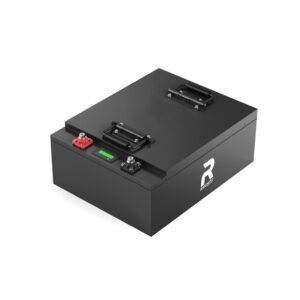How to Test a Car Battery with a Multimeter: Step-by-Step Guide
Testing a car battery with a multimeter involves measuring voltage to assess its charge and health. Set the multimeter to DC voltage (20V range), connect the probes to the battery terminals (red to positive, black to negative), and read the display. A fully charged battery should show 12.6V or higher. Values below 12.4V indicate a need for charging or replacement.
What Happens if a LiFePO4 Battery Gets Wet?
How Do You Prepare a Multimeter for Testing a Car Battery?
To prepare, ensure the multimeter is set to DC voltage (20V range) and the battery terminals are clean. Turn off the engine and all electronics. Connect the red probe to the positive (+) terminal and the black probe to the negative (-) terminal. For accuracy, test after the car has been idle for at least 1 hour to avoid surface charge interference.

When preparing your multimeter, consider these additional steps for optimal results. First, verify the multimeter’s calibration by testing a known voltage source, like a new AA battery (1.5V). Second, use anti-static gloves to prevent accidental discharge through skin contact. Third, inspect probe wires for fraying—damaged leads can give false readings. For older batteries with heavy corrosion, mix baking soda and water to clean terminals before testing. Always position the multimeter where you can read it without touching live components, reducing shock risks.
| Preparation Step | Key Details |
|---|---|
| Multimeter Setting | DC Voltage, 20V Range |
| Battery Rest Time | Minimum 1 Hour |
| Terminal Cleaning | Baking Soda Solution |
What Voltage Indicates a Healthy Car Battery?
A healthy car battery should read 12.6V–12.8V when fully charged. Readings between 12.4V and 12.6V suggest a partial charge, while anything below 12.4V signals a weak battery needing recharge. During engine cranking, voltage shouldn’t drop below 9.6V. Post-charging, if voltage remains low, the battery may have internal damage or sulfation.
Voltage interpretation varies with temperature and battery type. In freezing conditions (0°F/-18°C), a healthy battery may read 12.3V due to reduced chemical activity. AGM batteries typically maintain 12.8V–13.0V when charged. Use this reference table for quick diagnostics:
| Voltage Reading | Battery Status | Recommended Action |
|---|---|---|
| 12.6V–12.8V | Fully Charged | No action needed |
| 12.4V–12.5V | 75% Charged | Recharge within 2 weeks |
| 12.0V–12.3V | Partially Discharged | Immediate recharge |
How to Perform a Load Test with a Multimeter?
Simulate a load by turning on headlights or the ignition (without starting the engine). Observe the voltage: a healthy battery maintains above 12.4V under load. If voltage drops below 10V, the battery lacks capacity to hold a charge. For precise results, use a dedicated load tester or consult a professional mechanic.
Why Does a Car Battery Fail Even with Normal Voltage?
Voltage alone doesn’t reveal capacity. A battery may show 12.6V but fail due to sulfation, internal shorts, or degraded plates. Use a hydrometer to check electrolyte specific gravity (1.265–1.299 indicates full charge) or perform a conductance test. Cold-cranking amps (CCA) tests are critical for assessing starting power in winter conditions.
What Safety Precautions Are Essential When Testing?
Wear safety goggles and gloves to prevent acid exposure. Avoid sparks near the battery—hydrogen gas can ignite. Disconnect the negative terminal first when removing the battery. Never touch probes to both terminals simultaneously while the car is running, as alternator surge can damage the multimeter.
How to Interpret Fluctuating Multimeter Readings?
Fluctuations often stem from poor probe contact or corroded terminals. Ensure clean connections and retest. If readings swing wildly, check for parasitic drains (e.g., faulty alternator diodes) by testing for current draw with the car off. A draw exceeding 50mA indicates an electrical issue draining the battery.
Can You Use a Multimeter Instead of a Battery Analyzer?
Multimeters measure voltage and basic resistance but lack advanced diagnostics. Battery analyzers assess conductance, CCA, and state-of-health. For routine checks, a multimeter suffices, but for aging batteries, use analyzers or professional services. Multimeters can’t detect cell imbalances in AGM or lithium batteries, which require specialized tools.
Expert Views
“Many drivers mistake surface charge for actual battery health. Always let the battery rest for an hour before testing. Modern batteries with absorbent glass mat (AGM) technology require higher voltage thresholds—12.8V–13.0V when healthy. If voltage drops more than 0.2V after a load test, replace the battery immediately to avoid roadside failures.” — Automotive Electrical Specialist
Conclusion
Regular multimeter checks can prevent 70% of battery-related breakdowns. Focus on voltage stability under load, terminal cleanliness, and post-test maintenance. Pair multimeter data with annual professional testing, especially for batteries older than three years. Proactive monitoring extends battery life and ensures reliable vehicle operation.
FAQ
- How Often Should I Test My Car Battery?
- Test every 3 months and before long trips. Extreme temperatures accelerate battery wear, necessitating more frequent checks in hot/cold climates.
- Can a Battery Show 12V and Still Be Bad?
- Yes. A battery at 12V has only 50% charge. It may fail to start the engine due to low capacity, even if voltage appears marginally acceptable.
- Does a Multimeter Work for Hybrid Car Batteries?
- Standard multimeters test 12V auxiliary batteries in hybrids but can’t assess high-voltage traction batteries (200V+). These require factory diagnostic tools.
- What Causes a Battery to Drain Overnight?
- Parasitic drains from aftermarket electronics, trunk lights, or faulty control modules. Use a multimeter’s current mode (10A range) in series with the battery to identify excessive draw.
- Is 11.9V Too Low for a Car Battery?
- 11.9V indicates severe discharge (20% capacity). Recharge immediately. Persistent low voltage after charging confirms battery replacement is needed.
